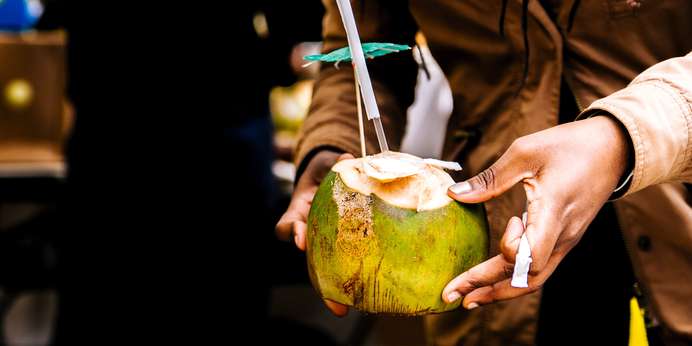
Coconut water is a multi-billion dollar industry that is expected to expand globally to US$8.3 billion by 2022.1 Consumers have been drawn to coconut water’s sweet, refreshing taste and unique chemical composition, similar to blood plasma, which is rich in carbohydrates and important nutrients such as magnesium, calcium, and phosphorus.1 These nutrients also make coconut water a naturally rehydrating sports drink which has increased market appeal. Fresh coconut water from young, green coconuts is particularly valued for a delicate taste and increased antioxidant benefits.
When first poured from the coconut shell, coconut water is a clear, colorless liquid that can be combined with the interior pulp for additional texture and variety. Color changes can occur in harvesting, cracking, sterilization, and storage processes so the final beverage can fluctuate from translucent white to pale yellow and even bright pink.1 Products can also include varying levels of pulpin the liquid depending on geographical region, harvesting practices, pasteurization, and market targeting, such as coconut beverages which are sold with pulp.
Sold coconut water’s final product is a combination of the color and pulp concentration, or turbidity of the water. With so many different variables, it can be challenging to maintain a consistent product. However, Hunter Spectrophotometric technology, with innovations in color and haze measurements, can offer innovative solutions for measuring both color and haze in a single reading of coconut water for consistent, reliable production. The Haze measurement can be substituted for a turbidity measurement done on a separate instrument.
DIFFICULTIES OF CONSISTENT COLOR AND HAZE IN COCONUT WATER
When your customer picks up a cooled bottle of coconut water from the store refrigerator, what they see through the plastic is a combination of color, usually light white to pale yellow, and pulp concentration. Strolling down the beverage aisle, there are many different brands of coconut water, each with a reliable, consistent appearance to build brand trust with their customer. But from shell to bottle to store, a consistent appearance isn’t so simple, as multiple variables, including chemical properties, harvesting and storage methods, and product differences, influence the final product.
These difficulties begin with the coconut. Since coconut water has a high pH, varying from 5 – 5.4, it is subject to rapid deterioration and fermentation once exposed to oxygen.1 Young coconut water, which is harvested one month earlier than mature coconuts, has a lower pH but higher phenolic content, as well as greater polyphenol oxidase (PPO) and peroxidase (POD) enzyme activity. The increased phenol content raises antioxidant levels and health benefits,, but higher PPO and POD also raises the water’s susceptibility to oxidation1 Within minutes of first cracking, yellow, amber, brown, or even pink discoloration can bloom across the harvested water’s surface.
To keep the water from spoiling early, whole nuts are gently harvested and stored for up to six days till extraction inside the plant. But new challenges arise with processing. During cracking and harvesting, coconut water can become cloudy from the accidental shell and coconut meat debris, or by adding pulp for a pulped coconut beverage. Once harvested, coconut water must quickly be sterilized and bottled which can also cause changes in the coloring. To prevent this, conventional thermal techniques, as well as cooling, freezing, or adding stabilizing juices such as pineapple, are quickly used to prevent further discoloration.2 In spite of these prevention methods, if the storage space is not properly temperature controlled, then discoloration can occur in storage and transportation to the store.
With all these different variables, the challenges of delivering a consistent coconut beverage can seem high. Consistency and reliability however, are the cornerstone of branding in a saturated market. It is also distinctly important to have a consistent color and haze for naturally harvested products to develop consumer trust.


